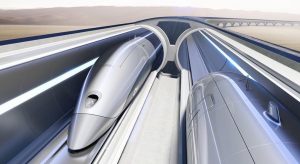 TÜV SÜD and the US company HyperloopTT have published the first ever complete hyperloop certification guideline defining the safety-related requirements relevant to this innovative high-speed transport system. The guideline is an important milestone in global standardisation and the development of harmonised regulations for national approval procedures which also includes individual components and systems for this type of technology.
TÜV SÜD and the US company HyperloopTT have published the first ever complete hyperloop certification guideline defining the safety-related requirements relevant to this innovative high-speed transport system. The guideline is an important milestone in global standardisation and the development of harmonised regulations for national approval procedures which also includes individual components and systems for this type of technology.
The guideline describes series of aspects including the core safety requirements for the transport capsules, the drive system, the environmental control and life support system, the tubes, and the evacuation procedure in case of emergency.
TÜV SÜD has reviewed the hazard analysis and risk assessment (HARA) of the HyperloopTT system and used it as the basis for developing a guideline that defines the key safety requirements for the design, construction, and operation of these systems.
The hyperloop certification guideline has also considered existing regulations and experience in fields such as rail, metro systems, cable cars, amusement rides, aviation, and the process industry, and aligned them to the specific requirements of hyperloop technology.
“Our generic guideline is our significant contribution to making an innovative technology like Hyperloop safe and reliable,” Ferdinand Neuwieser, CEO TÜV SÜD Industrie Service said.
The LA-based HyperloopTT is working on the development of a high-speed system which can transport passengers and freight over long distances at speeds of up to 1,100 km/h. The transport capsules are powered by electricity running through a system of vacuum tubes. The new transport technology is able to transport 28-50 passengers per capsule with an estimated daily ridership of up to 160,000 passengers.
The capsules are designed for ultra-high speeds by using composite materials and safety features. HyperloopTT has developed a new fuselage skin called Vibranium. Built with carbon-fiber and embedded sensors, the smart material transmits critical information regarding temperature, stability, integrity and more, all wirelessly and instantly.
“Hyperloop technology will revolutionize the future of transport systems. Extremely fast, energy-efficient, and zero-emission transport system can be smoothly integrated into existing infrastructures,” Andres de Leon, the CEO of Hyperloop TT said.
In 2019, the two organisations presented to the EU Directorate General for Mobility and Transport the first finalised generic guideline for design, operation, and certification for hyperloop systems.
Share on:



